Key takeaways:
- Success in education is measured by engagement and long-term impact rather than solely by test scores, emphasizing emotional connections with the material.
- Environmental education empowers individuals to become proactive stewards, fostering critical thinking and a deeper understanding of ecological issues.
- Utilizing a combination of qualitative and quantitative assessment tools is essential for evaluating educational resources effectively.
- Continuous improvement involves actively seeking feedback, staying updated on educational trends, and celebrating successes to enhance resource impact.

Understanding resource success in education
Success in educational resources isn’t just about how much information is shared, but rather how effectively that information transforms understanding. I recall a time when I introduced a hands-on project in a classroom, watching as students not only absorbed content but also developed a genuine interest in environmental issues. It was a beautiful reminder that true success in education often stems from engagement, not just achievement.
Measuring success also means considering the long-term impact of resources. Have you ever wondered why some projects resonate long after they’re completed? I’ve found that when students connect emotionally with the material—like witnessing the effects of pollution firsthand—they’re often inspired to advocate for change. This kind of lasting influence speaks volumes more than test scores ever could.
Another critical aspect is adaptability. I’ve experienced firsthand that no resource fits all learning styles or environments. Reflecting back, I learned that customizing resources to meet the diverse needs of students not only enhances understanding but also fosters a dynamic learning atmosphere. Isn’t it fascinating how flexibility can lead to greater success in education?
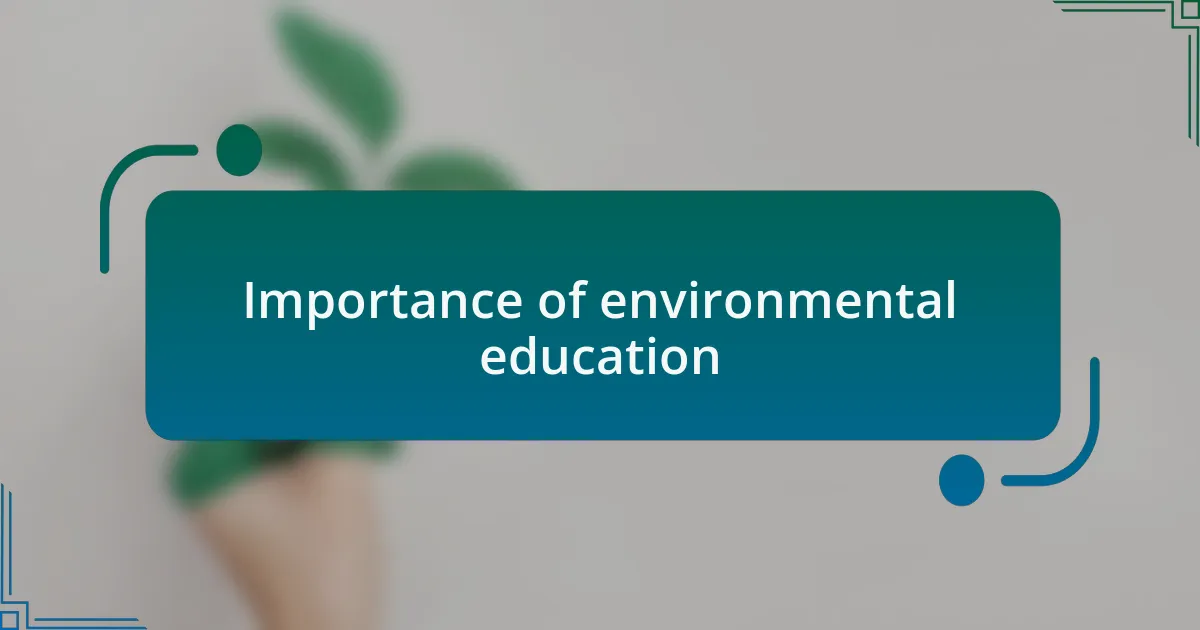
Importance of environmental education
Environmental education serves as a crucial foundation for fostering awareness about our planet’s health. I remember leading a nature walk with students, where we identified different plant species and their ecological roles. Witnessing their curiosity unfold as they made connections to their daily lives was inspiring; it highlighted how understanding our environment can cultivate an appreciation that drives both personal and community action.
Furthermore, the importance of environmental education goes beyond knowledge acquisition—it empowers individuals to become informed stewards of their surroundings. During a project on recycling techniques, I saw students not only grasp the concept but initiate their own recycling drives at school. Isn’t it remarkable how the right education can transform learners into proactive changemakers, ready to tackle pressing environmental challenges?
Ultimately, embracing environmental education equips individuals with critical thinking skills necessary for navigating complex ecological issues. In discussions about climate change, I’ve noticed that those with a background in environmental education approach the topic thoughtfully and confidently. This ability to engage in informed dialogue is vital in creating a more sustainable future—wouldn’t you agree that such preparedness is invaluable in today’s world?
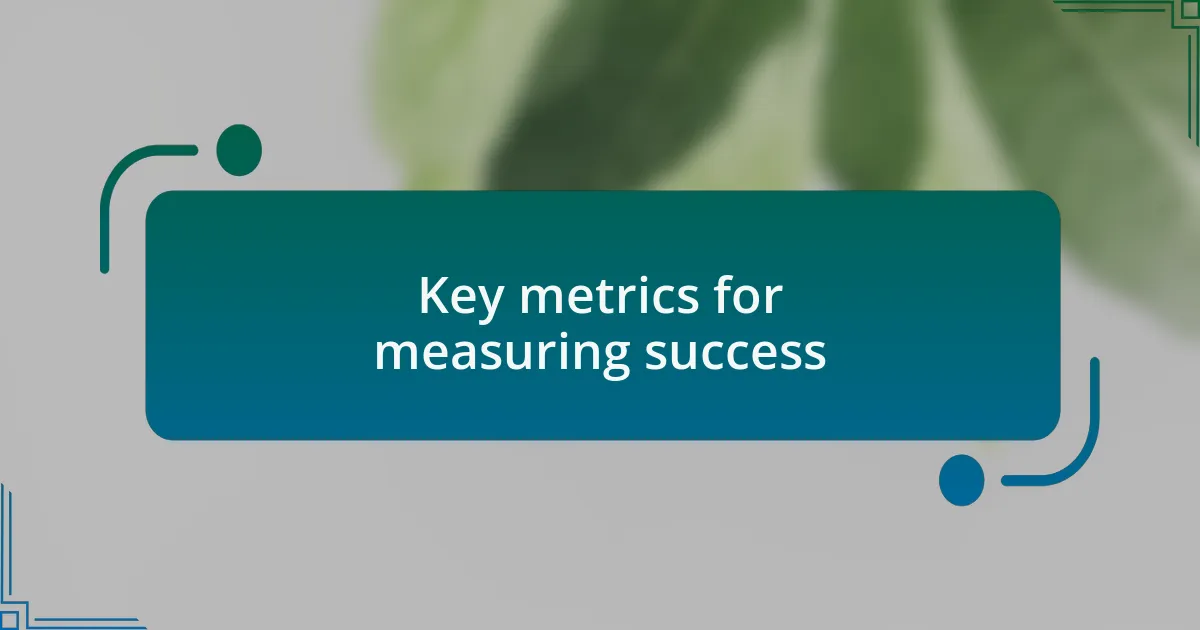
Key metrics for measuring success
When measuring the success of environmental education initiatives, engagement metrics often lead the way. I recall a workshop where participants actively shared their experiences with local wildlife. The vibrant discussions and feedback indicated that they were not only informed but genuinely engaged, showing me how engagement can reflect the success of an educational program. How do you measure whether people are truly absorbing the material?
Another critical metric is knowledge retention. I once conducted a follow-up survey after a series of environmental classes, and the results were eye-opening. Many students remembered not just facts but also expressed how those lessons influenced their daily choices, like opting for sustainable products. Isn’t it fulfilling to see that what we teach can linger in minds long after the initial lesson?
Lastly, behavioral change signals success in a tangible way. In my experience, I’ve seen participants take measurable steps towards sustainability, like reducing waste or advocating for greener practices within their communities. Wouldn’t it be exciting to witness a ripple effect, where one shedding light on sustainability inspires others to join in? Each of these metrics, whether engagement, retention, or behavior, paints a comprehensive picture of our educational impact.
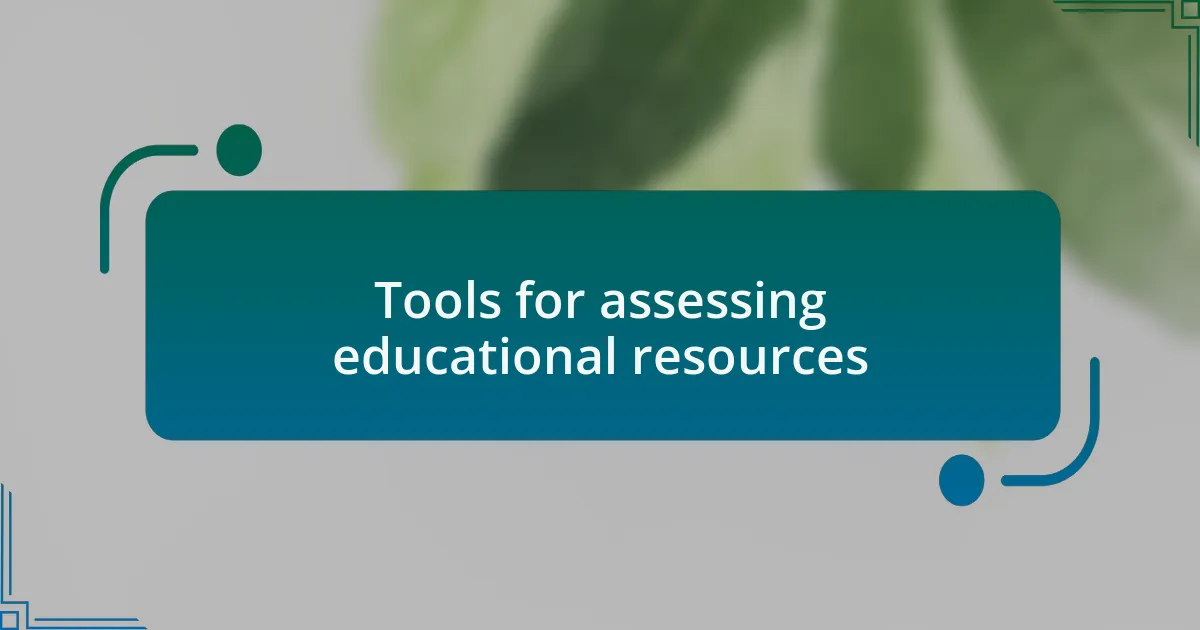
Tools for assessing educational resources
When it comes to assessing educational resources, I find that using both qualitative and quantitative tools is essential. Surveys and feedback forms provide valuable insights, and I remember devising one for a community garden initiative. Participants expressed their newfound appreciation for local ecology and shared personal stories about connecting with nature, illustrating how their learning transcended mere data.
On the quantitative side, I’ve relied on analytics tools to track website traffic and resource downloads. I recall a time when I was pleasantly surprised by the number of people who accessed our guides on sustainable living. It made me ponder, how many lives might be touched by effectively disseminating this information? The data paints a picture, but it’s the personal stories that breathe life into those numbers.
Additionally, observation tools, such as direct classroom observations or field visits, can be telling as well. In one memorable instance, I watched a group of middle schoolers planting trees while discussing climate change. Their enthusiastic chatter revealed not just engagement but also a deeper understanding of their impact on the environment. Isn’t it moments like these that remind us of the true value of effective educational resources? Each tool plays a unique role, helping us gauge our effectiveness in shaping environmental stewards.
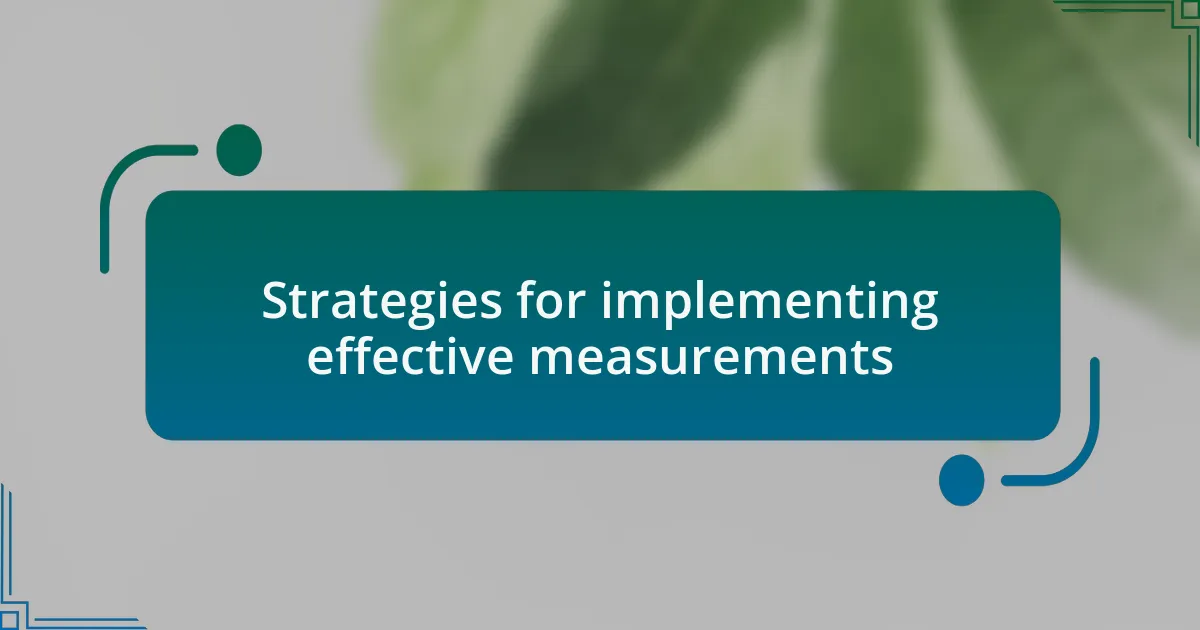
Strategies for implementing effective measurements
To implement effective measurements, I believe that setting clear goals is crucial. For instance, when we launched a campaign on recycling, I first defined what success would look like: a specific increase in recycling rates within the community. This clarity not only guided our efforts but also made it easier to measure impact and celebrate achievements along the way. Isn’t it rewarding to see tangible results from your initiative?
Another strategy I’ve found effective is engaging the participants directly in the measurement process. Once, during a series of workshops on biodiversity, I invited participants to set their own learning objectives and report on their progress. The feedback was enlightening. Not only did it foster ownership of their learning, but it also provided us with qualitative data that reflected their personal journeys—a testament to how education can influence mindsets and behaviors.
Lastly, employing a mix of short-term and long-term measurements can create a fuller picture of success. I once conducted a follow-up survey three months after a workshop on sustainable gardening to see if participants maintained their practices. The shift from initial enthusiasm to sustained behavior changes fascinated me. It made me realize that meaningful education often requires ongoing reflection and adaptation. Have you considered how the passage of time can shape the impact of educational resources?
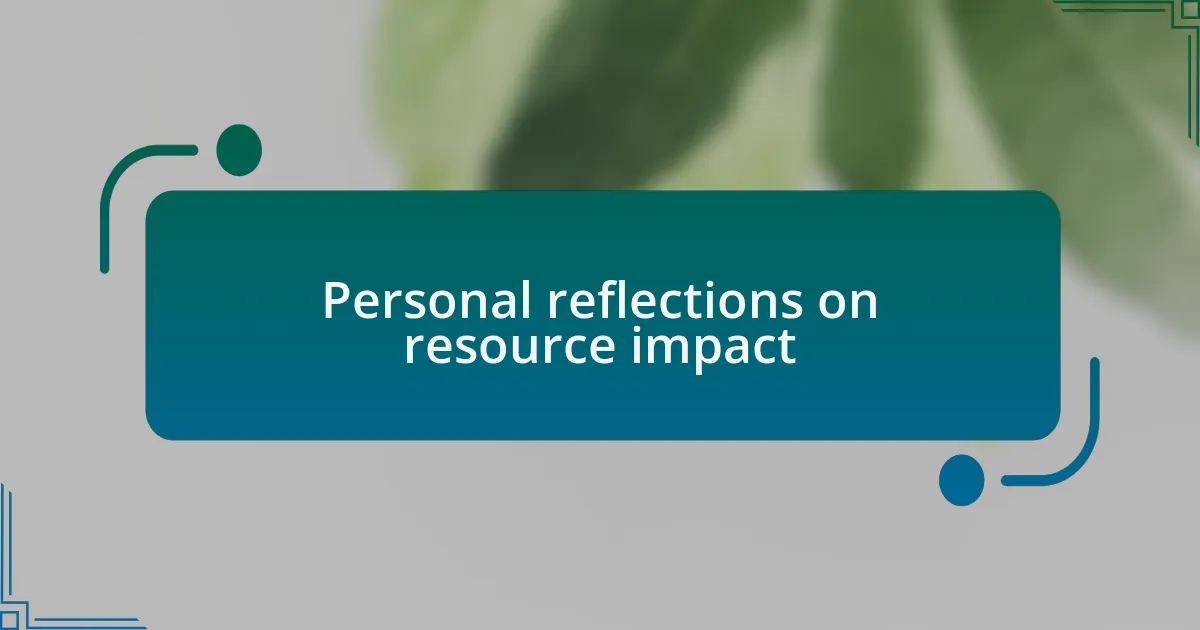
Personal reflections on resource impact
When I reflect on the impact of resources I’ve created, one memory stands out vividly. I once developed an online module focused on water conservation that resonated deeply with participants. Their heartfelt testimonials about how they changed their daily habits after engaging with the material reminded me of the profound responsibility we bear as educators. Isn’t it fascinating how knowledge can ripple through lives, prompting real change?
Another significant moment came after I introduced a resource on renewable energy at a local school. One student approached me, eyes bright with excitement, sharing how she organized a school-wide energy-saving competition. Her initiative demonstrated that even a single resource could ignite passion and lead others to take action. This experience reinforced my belief that the impact of educational resources extends beyond individual learning; it can inspire a collective movement. Have you ever witnessed a spark of inspiration in someone, knowing you played a role in it?
Looking back, it’s clear to me that measuring the impact of our resources isn’t just about numbers or surveys; it’s about the emotional connections forged in the process. During a recent community event, a parent approached me in tears, expressing gratitude for the tools we provided that helped his family live more sustainably. Such moments remind me that the ultimate goal of environmental education is to create a deeper understanding and connection to our planet, something that’s often felt rather than quantified. How do we, as educators, continue to foster those connections in our work?
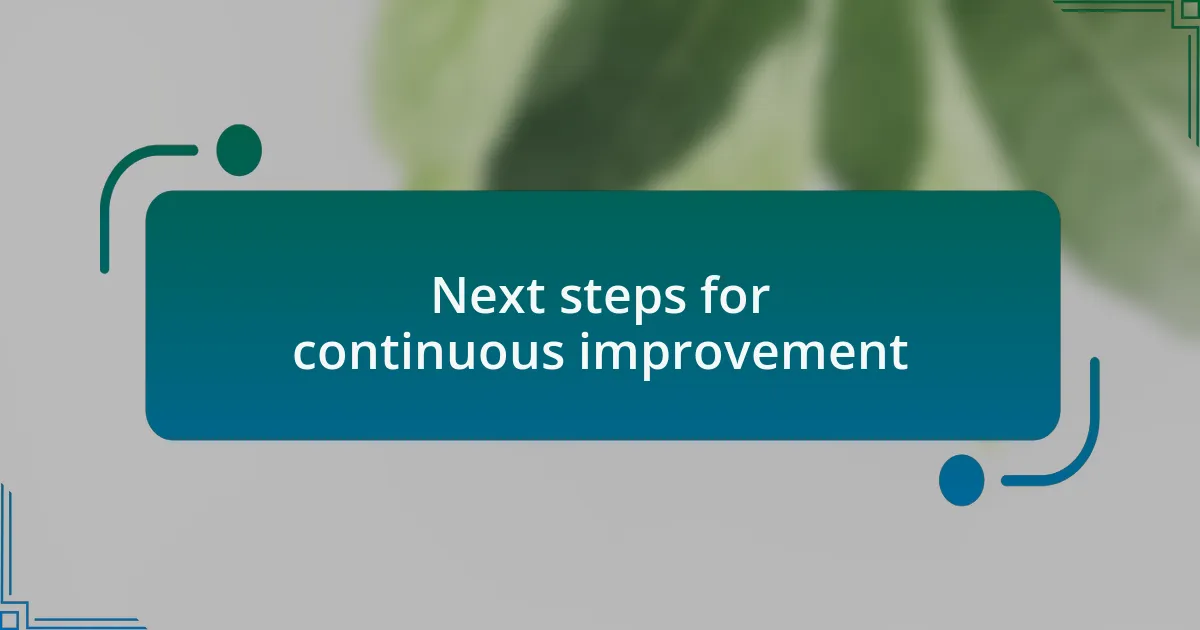
Next steps for continuous improvement
To embrace continuous improvement, I’ve learned the importance of actively seeking feedback from those who engage with my resources. For instance, after running a workshop on sustainable living, I distributed a quick survey but also encouraged open discussion. Hearing participants share their thoughts made me realize that there are often unexpected insights that can lead to significant enhancements. How often do we truly listen to our audience’s needs?
Another approach I find effective is to stay connected with educational trends and research in environmental education. I remember attending a conference where I discovered innovative teaching strategies that I hadn’t considered before. Implementing just a couple of those ideas in my resources created an immediate positive response. It made me think: are we tapping into the wealth of knowledge around us to refine our approaches continuously?
Lastly, I believe in celebrating small wins and making adjustments along the way. After noticing increased engagement in a project, I shared the success story with my team and encouraged brainstorming on how to replicate that success. This collaborative spirit is essential for cultivating an environment where each improvement feels like a shared victory. What could be the next small victory in your journey toward enhancing resource success?